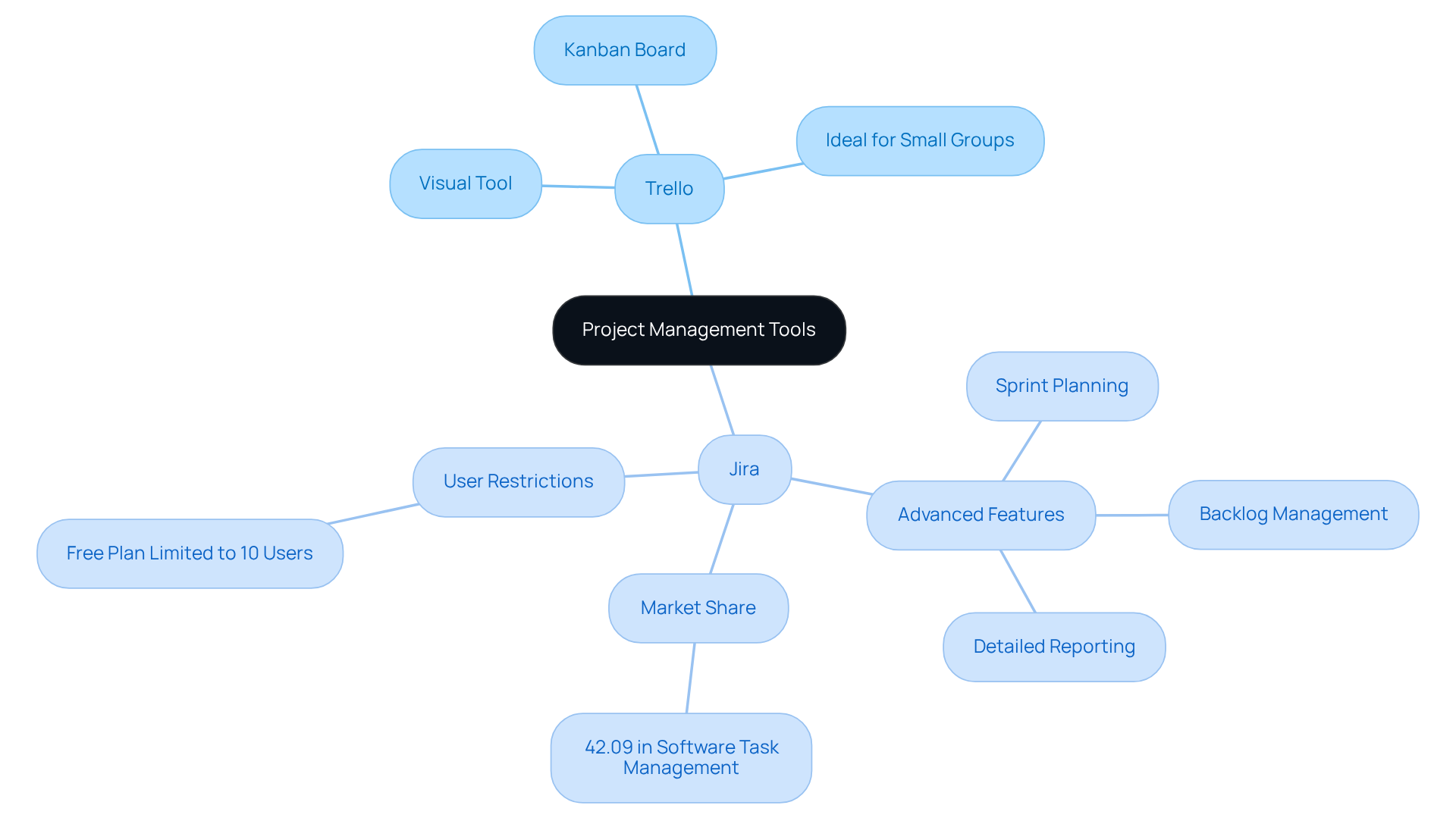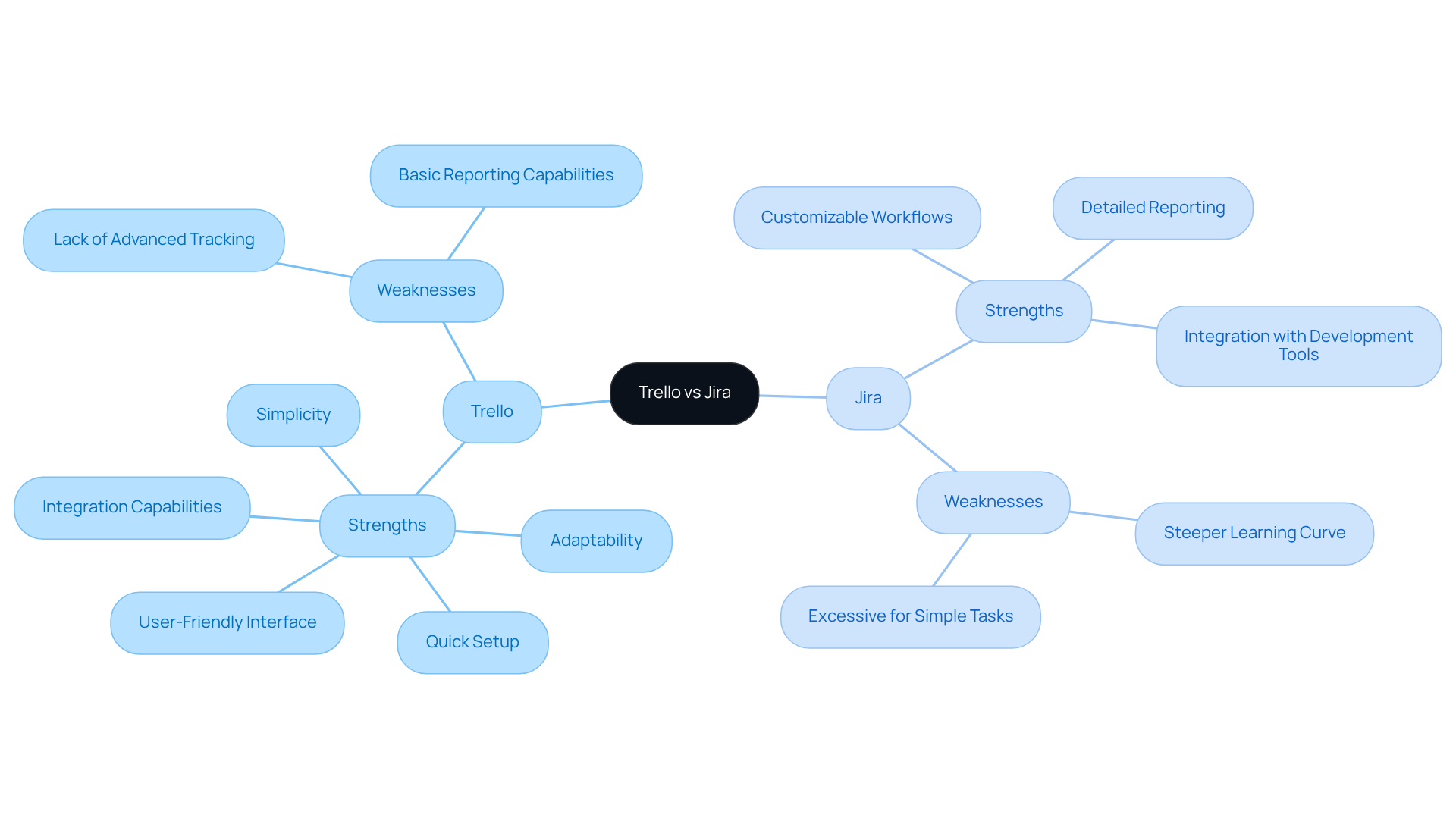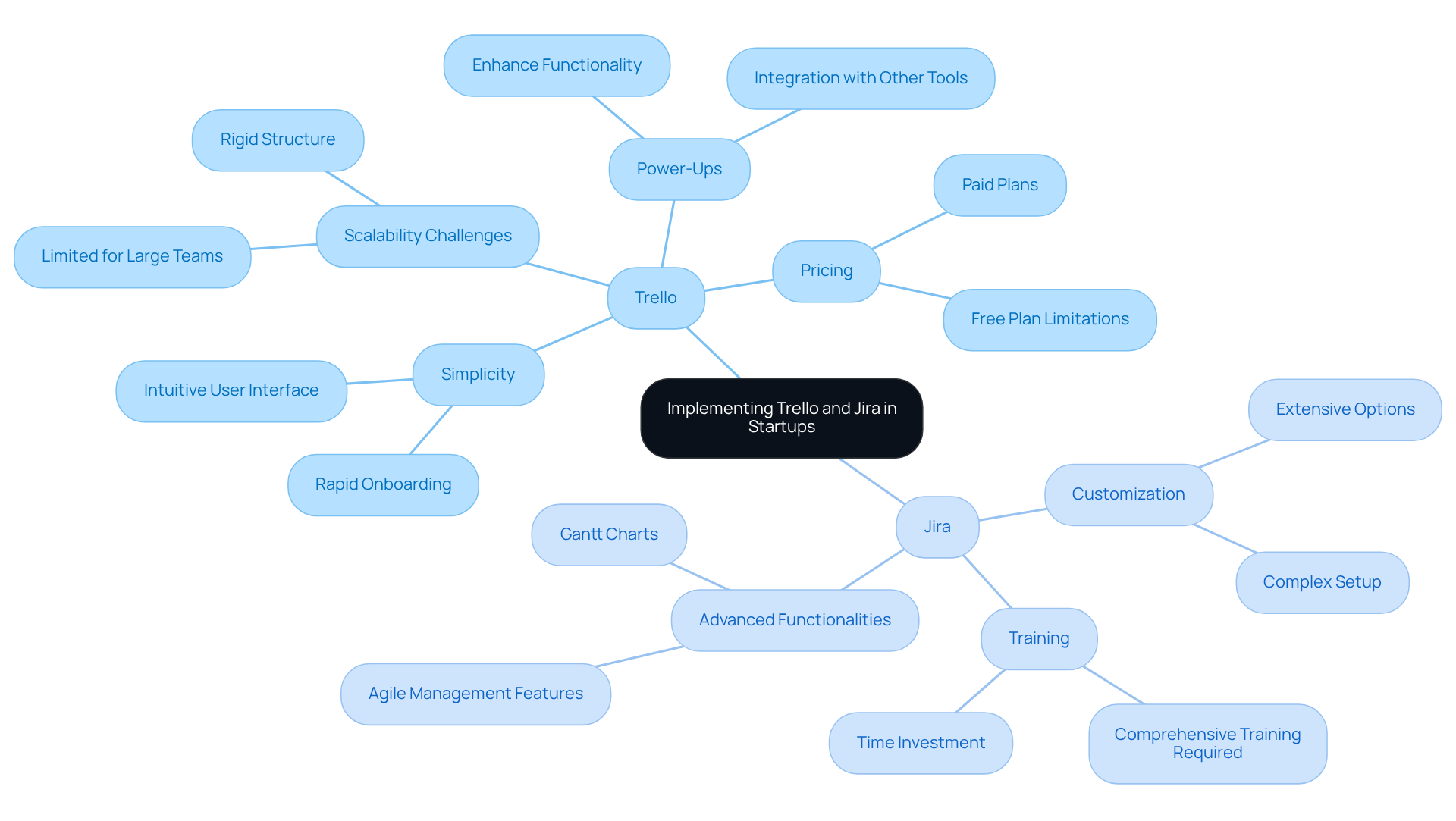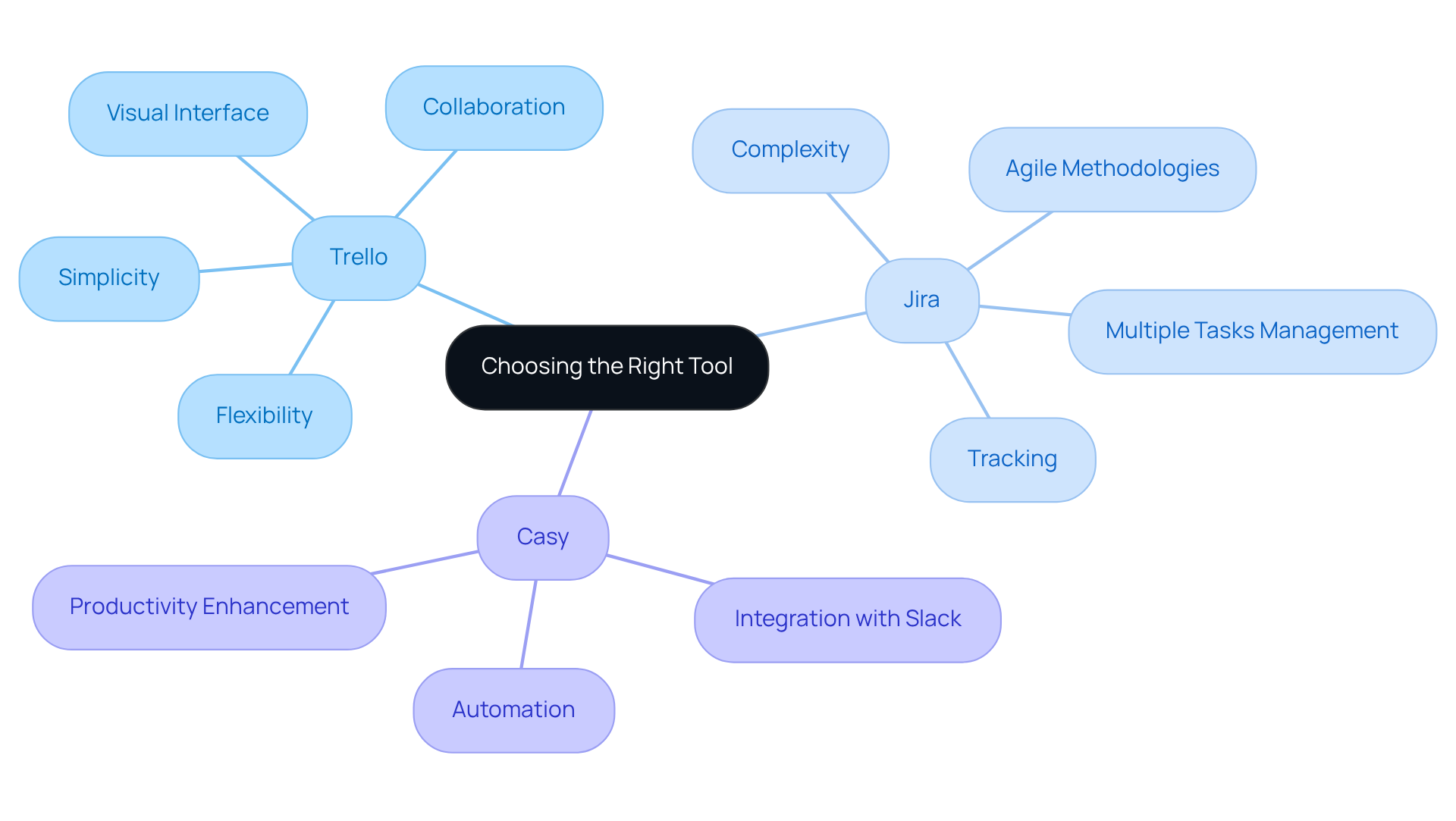Overview
The article examines the distinctions between Trello and Jira, asserting that Trello is ideally suited for startups in search of a straightforward, visual project management tool. In contrast, Jira is more fitting for teams requiring advanced task management features, particularly within software development. This differentiation is reinforced by the article's analysis of each tool's strengths and weaknesses.
- Trello's user-friendly interface caters to smaller projects
- Jira's robust functionalities are tailored for complex workflows and detailed reporting
Consequently, it is vital for startups to make their choice based on specific operational needs.
Introduction
Choosing the right project management tool is critical to a startup's success. With options like Trello and Jira—each offering distinct advantages—founders must make an informed decision about which platform aligns best with their team's needs. As organizations increasingly recognize the profound impact of effective task management, particularly in a landscape where 70% of initiatives fail, understanding the strengths and weaknesses of these tools becomes essential.
- Which tool will empower teams to navigate complexity while maintaining agility?
- How can startups leverage these insights to enhance their operational efficiency?
Overview of Trello and Jira for Project Management
Trello serves as a visual tool for overseeing work, utilizing a Kanban board system that allows teams to organize tasks through cards and lists. Designed for ease and adaptability, it is particularly well-suited for smaller groups or projects that require a straightforward approach.
In contrast, Jira emerges as a robust tool focused primarily on task management for software development teams. It boasts advanced features such as:
- Sprint planning
- Backlog management
- Detailed reporting
These features effectively address complex project needs. While Jira excels in user-friendliness and adaptability, it is available at no cost, making it an attractive option for startups. However, Jira provides a structured environment for managing intricate workflows and agile methodologies, albeit with user restrictions in its free plan, which may pose challenges for budget-conscious teams.
As of 2025, Jira commands a significant market share of 42.09% in the software task management sector, compared to another tool at 5.51%. This distinction underscores Jira's preference among organizations with more complex requirements, while the Trello vs Jira comparison shows that the alternative tool remains favored by teams seeking a more adaptable and user-friendly solution.
Importantly, organizations that do not incorporate task oversight into their strategy report a staggering 50% failure rate for initiatives, underscoring the critical need for selecting the right tool. Additionally, with 70% of initiatives globally failing, effective management tools like Jira are essential for achieving success. The integration of Trello vs Jira with Zapier enhances automation and workflow efficiency.

Strengths and Weaknesses of Trello and Jira
The platform's strengths are evident in its user-friendly interface, simplicity, and adaptability, making it an ideal choice for various projects, particularly for startups with limited resources. Users commend its quick setup and minimal training requirements, which enable immediate productivity. For instance, many startups have successfully employed visual Kanban boards to streamline their workflows, allowing teams to manage tasks effectively without the burden of complex setups. Additionally, the platform's integration capabilities with CRM systems and file-sharing applications enhance its productivity, establishing it as a valuable asset for startups.
Nevertheless, the application does present notable weaknesses. The lack of advanced tracking and reporting features can pose challenges for larger teams or more complex tasks, potentially leading to confusion and inefficiencies. This limitation is echoed by project management experts, including Rick Palaia, who note that while this tool excels in usability, it may fall short for organizations requiring robust analytics and detailed project oversight. Specifically, Trello's native reporting capabilities are perceived as rather basic, which can hinder larger groups.
In contrast, when considering Trello vs Jira, it is clear that Jira provides a comprehensive feature set that encompasses customizable workflows, detailed reporting, and seamless integration with other development tools, making it a formidable option for technical teams. Its strengths shine particularly in environments where complexity demands rigorous tracking and management. However, this complexity can be a double-edged sword; non-technical users often encounter a steeper learning curve, which may discourage them from fully leveraging the platform's capabilities. Consequently, some users find Jira excessive for less complex tasks, leading to frustration and inefficiencies.
User satisfaction ratings illustrate these dynamics, with the project management tool receiving high praise for its user-friendly design, while the Trello vs Jira discussion highlights Jira's powerful features tempered by usability concerns. As we look ahead to 2025, this tool remains favored for its accessibility, especially among startups, while in the comparison of Trello vs Jira, the latter continues to be a popular choice for teams needing advanced task management features. Furthermore, it is crucial to note that software for task oversight aids the average worker in saving 498 hours annually, underscoring the overall efficiency benefits of utilizing applications like Jira. Ultimately, for every $1 billion invested in projects in the US, $122 million was squandered due to poor project performance, reinforcing the significance of selecting the right project management tool to mitigate inefficiencies.

Implementing Trello and Jira in Startup Environments
In the context of a startup, introducing a project management tool necessitates a focus on establishing clear boards and lists that effectively represent the workflow. The platform's inherent simplicity facilitates rapid onboarding, enabling team members to adapt with ease. However, it's crucial to recognize that this tool may encounter scalability challenges for larger teams or complex projects, which could present obstacles as the startup evolves. Startups can leverage Power-Ups from the platform to enhance functionality as required. Recent features, such as the integrated calendar named Planner and the new Inbox feature, further streamline task management.
Moreover, Trello's pricing plans, including a generous free option, make it accessible for startups operating under budget constraints. In contrast, implementing a more structured approach is necessary when comparing Trello vs Jira. Teams must outline their workflows and task structures from the outset, as Jira's extensive customization options can be daunting. Allocating time for comprehensive training is essential to ensure that all team members can effectively utilize Jira's features, particularly for agile management.
When comparing Trello vs Jira, it is clear that Jira is better equipped for intricate tasks requiring advanced functionalities, such as Gantt charts, which Trello does not support. This organized preparation can significantly enhance productivity and streamline execution within a fast-paced startup environment. Are you ready to elevate your project management strategy?

Choosing the Right Tool: Trello vs Jira for Your Startup
Choosing the appropriate management tool for your startup hinges on the unique characteristics of your initiatives and the dynamics within your team. For startups that prioritize flexibility and simplicity, the discussion of Trello vs Jira often reveals that Trello emerges as a favored option. Its visual interface fosters collaboration and engagement, making it ideal for straightforward tasks where team members can effortlessly track progress and share updates. Conversely, if your startup is deeply involved in software development or requires meticulous tracking and reporting, the comparison of Trello vs Jira shows that Jira stands out as the more suitable choice. Its extensive features cater to complex workflows and agile methodologies, empowering teams to manage multiple tasks concurrently with precision.
Additionally, Casy, a groundbreaking project management tool, seamlessly integrates with chat platforms like Slack and Telegram, automating task creation and updates. This capability can significantly reduce administrative overhead and enhance productivity, making it an attractive option for startups aiming to streamline their management processes. Ultimately, the decision should align with your startup's operational needs and project demands.
Consider this: a Geneca survey revealed that 80% of respondents reported spending half their time on rework. This statistic underscores the critical importance of selecting the right tool for your team's success.

Conclusion
Selecting the right project management tool is crucial for startup founders aiming to optimize workflows and enhance team productivity. The comparison of Trello and Jira reveals distinct advantages each platform offers, catering to different project needs and team dynamics. While Trello excels in simplicity and visual appeal—making it ideal for smaller teams or straightforward projects—Jira stands out with robust features designed for more complex software development tasks.
Key insights from the discussion highlight that:
- Trello's user-friendly interface and adaptability make it an attractive option for startups with limited resources, enabling quick onboarding and immediate productivity.
- Conversely, Jira's comprehensive functionalities support intricate project management and agile methodologies, albeit with a steeper learning curve.
The choice between these tools ultimately hinges on the specific requirements of the startup, whether they prioritize flexibility or need advanced tracking capabilities.
In light of staggering statistics surrounding project failures, it becomes evident that investing in the right project management tool can significantly impact a startup's success. By carefully assessing operational needs and project demands, founders can leverage either Trello or Jira to streamline processes and foster collaboration. The decision should reflect not only current team dynamics but also consider future scalability, ensuring that the chosen tool will continue to support the startup's growth trajectory.
Frequently Asked Questions
What is Trello and how does it function?
Trello is a visual project management tool that utilizes a Kanban board system, allowing teams to organize tasks through cards and lists. It is designed for ease and adaptability, making it particularly suitable for smaller groups or projects that require a straightforward approach.
What are the key features of Jira?
Jira is a robust project management tool focused on task management for software development teams. Its key features include sprint planning, backlog management, and detailed reporting, which effectively address complex project needs.
How does Jira compare to Trello in terms of user-friendliness and adaptability?
While both Jira and Trello are user-friendly and adaptable, Trello is generally favored by teams looking for a more straightforward and flexible solution. Jira, on the other hand, is better suited for organizations with complex requirements due to its advanced features.
What are the limitations of Jira's free plan?
Jira's free plan has user restrictions that may pose challenges for budget-conscious teams, especially those managing intricate workflows and agile methodologies.
What is the market share of Jira in the software task management sector?
As of 2025, Jira holds a significant market share of 42.09% in the software task management sector, while other tools account for only 5.51%.
Why is task oversight important in project management?
Organizations that do not incorporate task oversight into their strategy report a staggering 50% failure rate for initiatives. This highlights the critical need for selecting the right project management tool to improve success rates.
How does the integration of Trello and Jira with Zapier benefit users?
The integration of Trello and Jira with Zapier enhances automation and workflow efficiency, making it easier for teams to manage their tasks and projects effectively.




